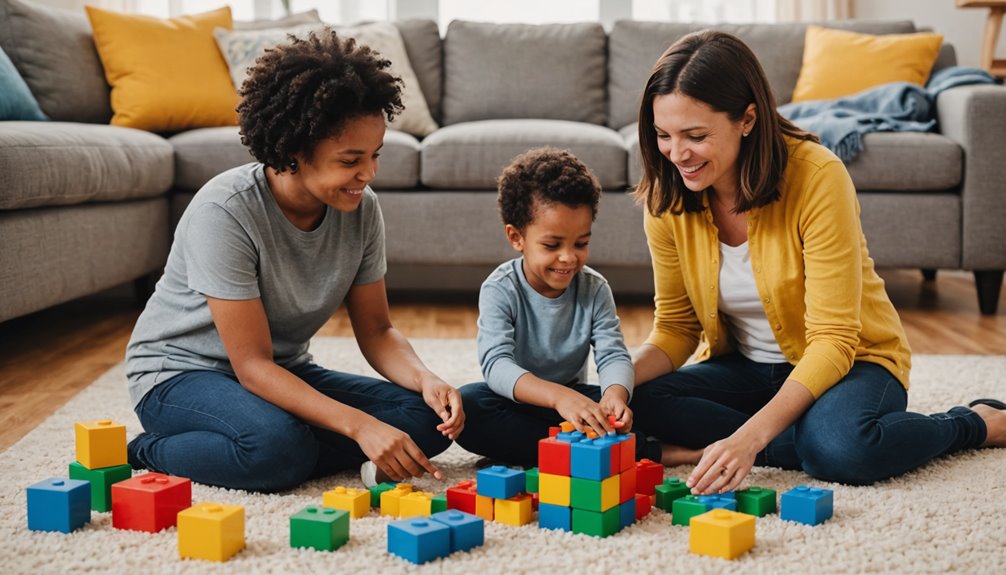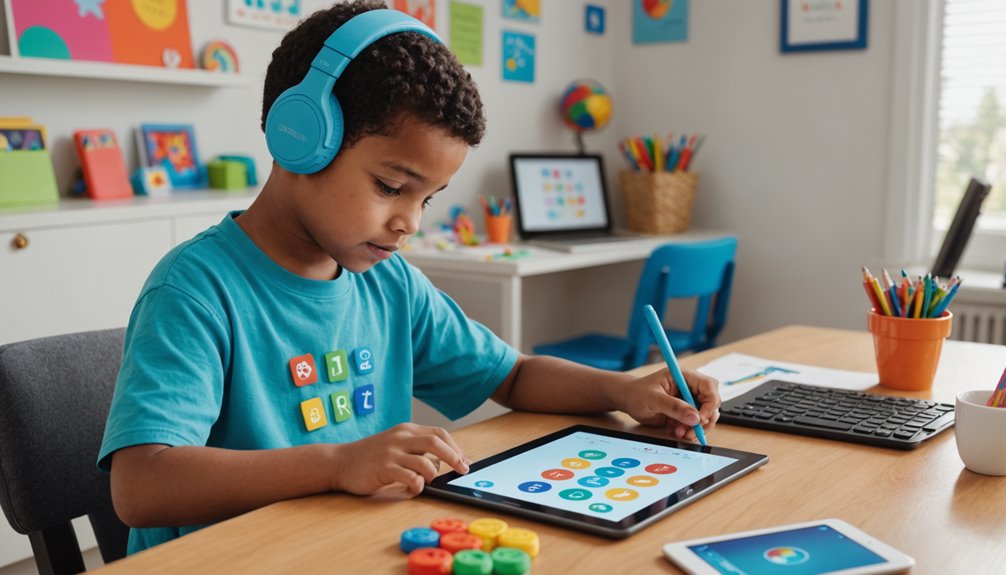Key Takeaways
- Incorporate ‘Ready Steady Go’ games and turn-taking activities to enhance interaction skills and language building.
- Use visual aids such as gestures, pictures, or communication apps to support nonverbal and verbal language development.
- Consistently practice eye contact and use positive reinforcement techniques during interactive play sessions to improve communication.
- Utilize assistive technologies like speech-generating devices or the Picture Exchange Communication System to support nonverbal children.
- Implement social narratives in daily routines, promote parental self-care, and advocate for professional resources to further communication development.
Tips to Support Children with Autism
Autism, a neurodevelopmental condition, often manifests as communication obstacles that significantly affect the child’s social interactions and language development. These autism communication barriers may appear as difficulty understanding and responding to social cues, expressing thoughts verbally, or even maintaining eye contact. Furthermore, these children may heavily depend on nonverbal communication, exhibiting repetitive speech patterns and limited verbal expression.
It’s vital to grasp these subtleties to cultivate a nurturing setting. Acknowledging these obstacles enables the use of effective strategies tailored to their requirements. Visual aids, technology-supported communication devices, and social narratives can serve as practical resources to bolster their communication advancement at home.
Addressing these obstacles is not about enforcing conformity but about assisting the child in navigating their surroundings, enhancing their capacity to articulate themselves, and engaging with others. By understanding these autism communication obstacles, we position ourselves better to support children with autism in their path of language development and social engagement. This comprehension is the initial step towards transforming their obstacles into strengths and fostering a nurturing setting that promotes their development.
Furthermore, employing principles from pediatric occupational therapy can help enhance the child’s cognitive abilities and fine motor skills, thus improving their communication and interaction capabilities.
Encouraging Early Interaction Skills
Fostering early interaction skills in children with autism forms a pivotal cornerstone in their communication development. Encouraging these skills at home is achievable with a strategic yet nurturing approach, helping them to improve their social engagement capabilities.
Implementing practices such as prompting eye contact during games and conversations can significantly impact a child’s communication abilities. Additionally, using Ready Steady Go games can support the development of anticipation and patience, which are critical aspects of successful social interaction.
Modeling turn-taking during games and activities not only instills the importance of reciprocal interaction but also assists in language understanding and usage. Moreover, providing explicit modeling and encouraging two-word utterances contributes to language expansion and improved pronunciation development.
Lastly, engaging in activities that promote communication and social interaction can significantly support the development of these early interaction skills in children with autism. Introducing role-playing exercises as a part of their routine can help them comprehend and learn to navigate various social situations effectively.
| Strategy | Impact |
|---|---|
| Promoting Eye Contact | Improves communication abilities |
| ‘Ready Steady Go’ Games | Cultivates anticipation and patience |
| Modeling Turn-Taking | Assists in language understanding |
| Encouraging Two-Word Utterances | Contributes to language expansion |
| Activities Promoting Interaction | Supports early interaction skills
Implementing Language-Building Strategies

While early interactive skills form a crucial foundation, implementing language-building strategies is of utmost importance for improving communication abilities in children with autism. Parents and caregivers can use visual support strategies at home, such as gestures and pictures, to assist language development, especially for nonverbal children. This approach offers a concrete representation of words and concepts, strengthening comprehension and expressive language potential.
Promoting turn-taking in communication nurtures interaction and language skills. This practice supports social communication by teaching children the back-and-forth nature of conversation. It not only boosts their listening skills but also their ability to respond in a socially appropriate manner.
Another effective strategy involves offering choices within activities. This prompts children to use new language in a meaningful context, promoting communication growth. For example, during mealtime, asking the child if they prefer an apple or a banana supports verbal expression.
Techniques such as the DIR/Floortime model, which emphasizes relationship-building through play, can help enhance the social, emotional, and cognitive capacities of children with autism.
Incorporating these language-building strategies into daily routines provides a structured environment for language learning. Routine predictability aids in language understanding and use. Finally, be attentive to your child’s nonverbal communication cues, as this can significantly improve their expressive language development.
Enhancing Nonverbal Communication
Enhancing nonverbal communication, including gestures and eye contact, is vital in fostering effective communication in children with autism. These nonverbal cues, alongside other body language expressions, can serve as an alternate avenue for these children to express their needs and feelings, especially for those who struggle with verbal communication. Therefore, it is essential to educate parents and caregivers on the importance of these cues and how to respond appropriately to facilitate better interaction and understanding. It’s also crucial to understand that pediatric therapy, utilizing task analysis and modeling, can be a beneficial tool in teaching and reinforcing these nonverbal cues and enhancing overall self-care abilities in children with autism.
Gestures for Better Interaction
A significant part of nonverbal communication, gestures, holds a vital place in improving interaction capabilities in children with autism. By utilizing gestures, a child can express their needs, wants, and emotions more effectively. These nonverbal cues are designed to aid in communication development, serving as a bridge to verbal communication for nonverbal autistic children.
Encouraging the use of gestures does more than facilitate communication; it also promotes social interaction. This is of particular importance for children with autism, who often struggle with understanding and engaging in social cues. By learning to use gestures, they gain a tool that can help them interact more comfortably with others, fostering an environment for better understanding and relationship building. Additionally, the development of these nonverbal cues can also positively impact the development of a child’s fine motor skills, which play an essential role in tasks such as writing and drawing.
Encouraging Eye Contact
Building on the foundation of gestures, another critical area of nonverbal communication to consider is eye contact. Encouraging eye contact in children with autism can significantly improve their nonverbal communication skills and social interactions.
Research indicates the integral role of eye contact in the development of communication abilities in children with autism. By gently prompting and reinforcing eye contact, caregivers can further support the growth of crucial social skills. This simple yet impactful practice allows for better engagement and a deeper understanding of emotions, leading to improved communication outcomes.
Consistent practice and positive reinforcement are essential in promoting eye contact. This can be achieved through interactive play, storytelling, or even during routine daily activities. Gradually, as children with autism become more comfortable with eye contact, they begin to feel a stronger sense of connection during interactions.
Utilizing Assistive Technologies

In the field of autism support, assistive technologies have emerged as a game-changing tool for facilitating communication. These technologies, such as speech-generating devices (SGDs), offer individualized and interactive ways for nonverbal children to express themselves. By providing alternative communication channels, SGDs enable children with autism to convey their thoughts and needs effectively.
Another critical technique for communication development is the use of Picture Exchange Communication Systems (PECS). These visual aids are designed to help nonverbal children initiate communication using pictures. PECS not only improves the child’s ability to communicate but also promotes independence.
Furthermore, diverse communication apps are now available that specifically cater to the communication needs of children with autism. These apps offer a wide range of features that can be tailored according to the child’s needs and abilities, encouraging active engagement and facilitating communication.
Visual aids, coupled with assistive technologies, play an essential role in improving the communication abilities of children with autism. These tools not only support communication development but also instill a sense of autonomy in these children, thereby enhancing their overall quality of life.
Incorporating Social Narratives
Exploring the complexities of social situations can be challenging for children diagnosed with Autism Spectrum Disorder. Social stories, structured clearly, can be an effective tool in helping these children grasp social cues, norms, and behaviors. By addressing specific communication hurdles, these brief anecdotes or visual aids can be tailored to foster social skill development.
Visual storytelling, a central element of social stories, boosts comprehension and communication in children with autism. It translates abstract social concepts into more tangible and visual formats, making them easier to grasp. This approach, when integrated at home, can significantly enhance a child’s social communication skills.
Moreover, social stories can bolster positive interactions in everyday scenarios for children with autism. They offer context, elucidate the potential reactions of others, and propose appropriate responses. These stories nurture a sense of predictability and control, reducing anxiety and bewilderment in social situations.
Integrating social stories into a child’s daily routine at home can thus offer a structured approach to navigating social environments, making interactions more foreseeable and manageable. It’s a powerful strategy to bolster the communication development of children with autism.
Parental Support and Self-Care

Undeniably, parents serve as essential pillars in fostering communication development in children with autism at home. Their role is multifaceted, involving not just direct interaction but also advocacy, resource-seeking, and maintaining their well-being through self-preservation.
Parents’ self-preservation is essential. It enables them to maintain the patience and energy necessary to support their child’s development. This includes both physical and mental health, which can be nurtured through regular physical activity, balanced nutrition, and mental health support such as therapy or mindfulness.
The significance of seeking professional guidance cannot be overstated. Experts can provide valuable insights and practical strategies to help parents support their child’s communication development and advocate for necessary resources and services.
| Self-preservation Methods | Professional Resources | Advocacy Strategies |
|---|---|---|
| Regular Physical Activity | Speech Therapists | School Meetings |
| Balanced Nutrition | Psychologists | Local Services |
| Mental Health Support | Autism Specialists | Government Resources |
Parents can provide more effective support for their child’s communication development on the autism spectrum by prioritizing self-preservation and utilizing professional help.
Frequently Asked Questions
What Is the Most Effective way to communicate with a Child Who Has Autism at Home?
Utilizing visual aids, technology, and social stories can effectively improve communication with autistic children. Modeling behavior, providing choices, and seizing everyday learning opportunities also serve as beneficial strategies for promoting their communication development.
How Do You Teach a Child with Autism to Talk at Home?
To teach an autistic child to talk at home, utilize visual aids, communication technology, and structured conversations. Create a quiet, distraction-free environment and model nonverbal communication. Always respond to their communication attempts to foster language development.
How to Help a child with Autism at Home?
How can you improve an autistic child’s learning at home? You can effectively train an autistic child at home by implementing structured routines, using positive reinforcement, creating a calm environment, employing autism-specific technology, and coordinating with therapists for individualized strategies.
How to Develop Communication Skills in Autism?
Developing communication skills in children with autism involves encouraging imitation of sounds and gestures, using visual supports, modeling communication behaviors, providing choices to stimulate language, and integrating language-building activities into daily routines.
Conclusion
To wrap up, nurturing communication, along with other skills in children with autism, is similar to tending to a garden, necessitating patience, strategies, and resources. Through early interaction, language development tactics, improving nonverbal communication, assistive technologies, social narratives, and parental support, a fertile environment for healthy communication growth can be established. It is crucial that caregivers also prioritize self-care, ensuring they remain resilient gardeners in this process of nurturing their child’s communication development.


Recent Comments